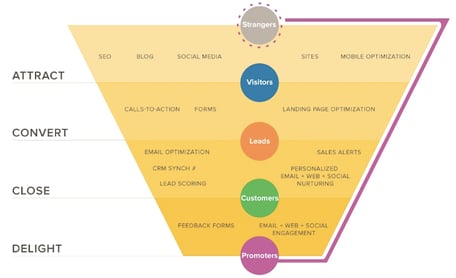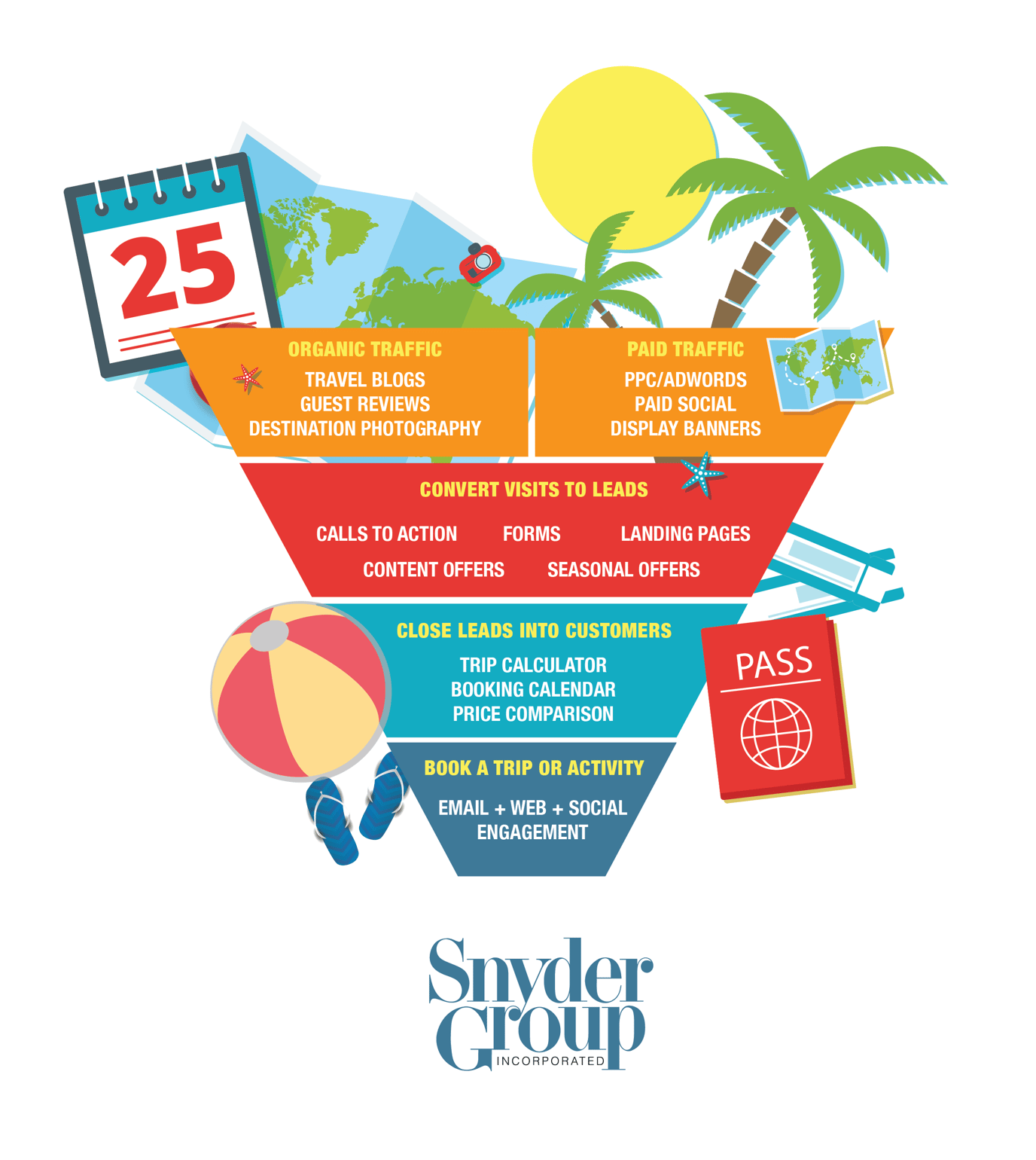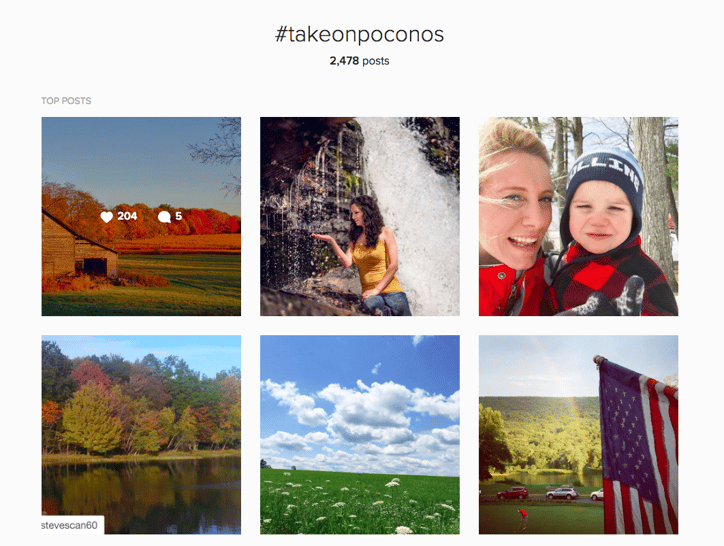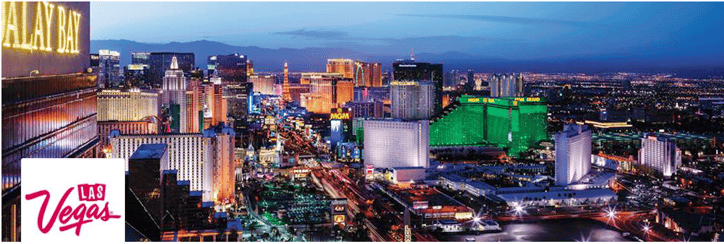Travel and tourism is one of the hottest categories for innovative marketing. There are so many possibilities for content from destination photography to travel blog posts to local guide ebooks that inbound marketing for the travel and tourism industry only makes sense. Content for travel marketing comes naturally as guests provide a steady stream of posts and images documenting their adventures. If your organization is involved in the travel and tourism industry and its not already implementing inbound marketing strategies, it's time to step up to the plate.
We've all seen this generic inbound marketing funnel.

It's practically an inbound marketing industry standard by now--and sure it's useful to grasp the basic concept of inbound marketing, but it doesn't cover everything. And it certainly doesn't cover the travel and tourism industry's marketing needs specifically.
This is the marketing funnel you've been waiting for:

Now, let's take it from top to bottom:
How to Generate Organic Traffic with SEO:
Be honest, here, how many times have you heard a friend rave about their latest vacation, seen some spectacular image on social media, or read a fun blog post about someone's travel adventure, and thought to yourself: "I want to do that!"? And how many times have you seriously wanted to do that and done a little research on reviews to see what other people's experiences have been like? That's the magic of inbound marketing for the travel and tourism industry. Everyone wants to talk about and SHOW their experiences online. All you have to do is create a strategy around what people are already doing with your product or service. For example, you could create a hashtag on social media specific to your company and have your guests post photos on their personal networks using your hashtag like the Pocono Mountains Visitors Bureau who launched a campaign and established #TakeOnPoconos to develop user-generated content that equally served as a generator for organic traffic.
How to Use Paid Traffic to Boost Your Campaigns:
Generally the content for your paid traffic will be similar if not the same for your organic traffic--but this time you've got a little extra help from your friend, Benjamin. While there are certainly pros and cons (mostly financial) to Paid Traffic, one of the major pros is the insight you can glean with PPC (AdWords). Since Google encrypted its searches, marketing automation platforms can no longer provide you with insights like the exact search term or phrase that someone used to land on your website page. When you run an AdWords campaign, however, you instantly have access to this information, which can be highly useful for an organic strategy, particularly as it pertains to keywords you should target for blogs. The other main benefit of Paid Traffic is that it makes tracking your return on investment (ROI) a heck of a lot easier. Because so much of the traffic for the travel and tourism industry is referral traffic (whether from someone the visitor knows in person or from someone who influences your visitors), it can be particularly difficult to track ROI for leaders in the travel and tourism industry. Paid traffic in AdWords or Social can be extremely advantageous. For example, setting up ads on social media platforms like Facebook or Instagram is highly customizable as far as testing goes, which enables you to ultimately choose the best creative for your 'boosted' or 'sponsored' posts, not to mention all of the targeting capabilities and tracking insights that the platforms provide for you. The Las Vegas Convention and Visitors Authority launched a campaign to increase visitors to Las Vegas and Southern Nevada using boosted videos not only on Facebook but also on Instagram to increase awareness. Check out their success story here.
How to Convert Visits to Leads:
After you've attracted visitors to your site through paid and organic traffic, it's time to implement strategies that make your website more than just a website. Make your site work for you by creating functional content such as content offers and then gating those more middle of the funnel offers with a call-to-action(CTA), a landing page, and a short form that asks for simple information such as a name and an email address. The value of your content offers should be comparable to the value of the information being requested from the visitor. For instance, if you offer an eBook that covers the top ten vacations for families in the summertime, you could probably ask not only for a name and email address but also how many children are in the family and the ages of the family members. This extra information allows your sales team to develop a more accurate profile of the lead, which then allows for the sales process to be positioned less as a sales pitch and more of a let-me-help-you pitch.
How to Nurture Leads into Customers:
Once your visitors have been converted to leads with the variety of your content offers and seasonal promotions, the next step is to turn them into customers. Get them using your products, like a trip calculator, availability/booking calendar, or even a price comparison to show them exactly how you differentiate yourself from your competitors. If your particular business does not offer services such as flights, hotels, or rentals of any sort (where you might expect a price comparison), such a tool could still be extremely useful for leads who are looking for activities but haven't quite booked a flight, hotel, or rental vehicle. The whole point of inbound marketing for the travel and tourism industry, and really inbound marketing as a whole, is to first get traffic to your website, but ultimately turn your website into the powerhouse it should be. Offer people a functional reason to keep coming back to your site, and they surely will, just like Time Inc.'s MONEY who created an amazing interactive travel map that lets you choose a budget for travel and returns the cost of one day in the location of your choosing.
Book a Trip or Activity:
When your customers finally book their trip or activity with your company, don't expect their buyer journey to suddenly end. While you've certainly achieved the initial goal of ultimately turning a website visitor into a customer, there is work yet to be done. Your customers are your greatest asset as a business, and as you surely already know, it costs more to gain new customers than maintain current one. Therefore, you must continue to appeal to your existing customer base while also encouraging them to share their positive experiences with their personal networks. Encourage guests and visitors to tag your business location by offering discounts and deals. Set up workflows that keep your customers engaged even when they return home with a simple email survey asking them if they had fun or an additional incentive for completing a review such as a discount on their next travel and leisure purchase.




